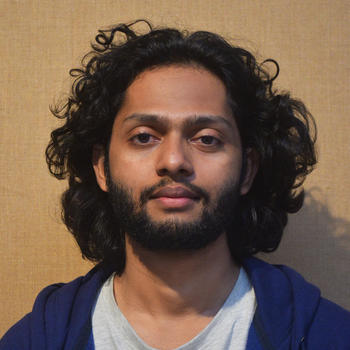Jyothidas Kelambath Vadakkina

Interweaving Performance Cultures
Doctoral Candidate 2017/18
Jyothidas Kelambath Vadakkina is an artist and researcher currently pursuing his PhD in Visual Studies from the School of Arts and Aesthetics, Jawaharlal Nehru University, New Delhi. His interest in printmaking developed during the early days of his studies in Fine Arts at Indira Kala Sangit Viswavidyalaya, Khairagarh, Chattisgarh, where he graduated from the Graphics Department in 2008. He did his post graduation in printmaking from the Faculty of Fine Arts, Maharaja Sayajirao University, Baroda, Gujarat. His MPhil dissertation was titled Where Does the Printmaker Stand? Conventional Print in the Contemporary Time. His prints usually bear images from the realm of the fantastic, where metaphors subverting structures of power, both human and ‘divine,’ are at play. His images draw from ritual performances of northern Kerala, his interest in the urban everyday, and from positioning bodies within the dynamics of power. He has a keen interest in political cartooning and comics. His work Urban Village Conundrum was part of the exhibition Urban Implosion heldat the Asia Culture Centre, Gwangju, South Korea.
Research Project
Transnational Avenues of Cultural Exchange Between India and Germany: Histories of Chromolithography, Travelling Graphic Art Exhibitions, and Theatre Posters.
Lithography’s invention by Alois Senefelder in the late eighteenth century has contributed immensely towards the production and dissemination of knowledge in various countries. Even though this technology of mass reproduction of texts and images was introduced to India by the British colonial establishment, its popularity was made possible by the proliferation of images from Indian mythology by a number of Indian artists. The later developments in multi-color lithographic prints such as oleographs revolutionized Indian visual culture. Many of the popular prints of the nineteenth century, designed by renowned Indian artists, were printed in Germany and imported to India.
This research project intends to focus on the many cultural and technological transactions between Germany and India. It also intends to mark how these connections received a new impetus in the era of cultural exchange following World War II, when a number of German exhibitions of graphic art travelled to India. This project will also look at the routes of printed posters of theatrical productions, which travelled to India especially from the German Democratic Republic. These investigations into the various aspects of the transnational exchange of technical as well as aesthetic conventions in the field of printmaking is critical to my doctoral thesis titled Matrices in the Modernist Matrix: A Study of Modernist Printmaking in India. My research interests include concepts related to matrix, internationalism in the context of Indian modernism, the politics of image multiplication and dissemination, and printmaking and regional modernisms in India.
Recommended Readings
- Armstrong, Carol. “Seurat’s Media, or A Matrix of Materialities”. Grey Room. Winter 2015, No. 58: 6–25.
- Baudrillard, Jean. Simulacra and Simulation. trans., Glaser, Sheila Faria. Michigan: University of Michigan Press, 1994.
- Benjamin, Walter. The Work of Art in the Age of Its Technological Reproducibility, and Other Writings on Media . Doherty, Brigid, Levin, Thomas Y and Jennings, Michael W (eds) The Belknap Press of Harvard University Press, 2008.
- Kapur, Geeta. When Was Modernism: Essays on contemporary cultural practice in India. New Delh: Tulika Books, 2000.
- Sengupta, Paula. ed. The Printed Picture: Four Centuries of Indian Printmaking Vol 1and 2. New Delhi: Delhi Art Gallery, 2012.
